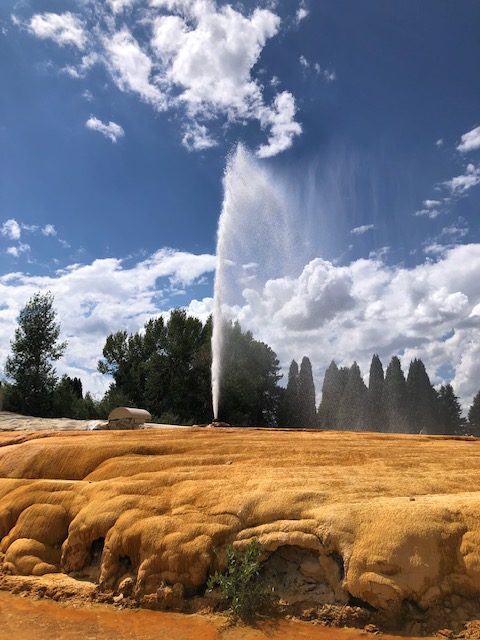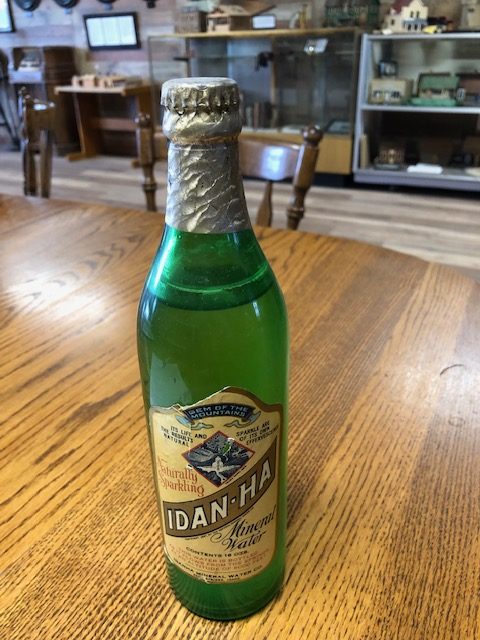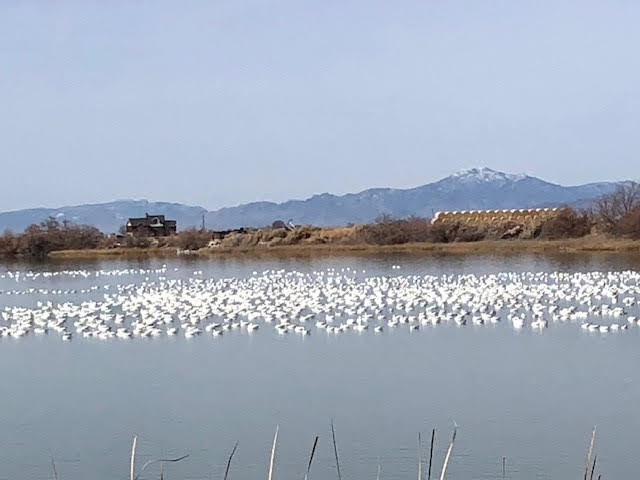
Douwe Blumberg, Artist
Courtesy & Copyright Mary Heers, Photographer
 Locomotive Advancing In Buffalo Eye
Locomotive Advancing In Buffalo Eye
Douwe Blumberg, Artist
Courtesy & Copyright Mary Heers, Photographer
 “Distant Thunder,”
“Distant Thunder,”
Michael Coleman, Artist
at Golden Spike National Monument
Courtesy & Copyright Mary Heers, Photographer
 Monument to their Memory
Monument to their Memory
Ilan Averbuch, Artist
Golden Spike State Park at Reeder Ranch, Brigham City, UT
Photo Courtesy & Copyright Mary Heers, PhotographerEarly this spring, a semi-truck with a long flat bed pulled into the USU parking lot next to the cemetery and parked. Lashed down firmly on the flat bed was a giant railroad spike, covered in gold leaf and very impressive to see from a distance. But walking up to it, I could see it was covered in sculptured forms. There was an Indian astride a horse; the shaggy head of a buffalo. But what really caught my attention was the close up of the buffalo eye staring right at me. Reflected in the pupil was a steam engine, coming down the tracks, right at me. I felt the chill of the inevitable crash.
The train brought hunters with guns, hide hunters who killed and took only the hides, shipping them by the bale to industries back east. When there were no more buffalo to be shot, they collected the bones and shipped them to St Louis to be crushed into fertilizer. You could see the crash coming, and knew it would be devastating – to the buffalo and the Indians whose livelihood depended on them.
Walking around to the other side of the spike, I found a very different story. Here were the laborers who had laid down the Transcontinental tracks – the Chinese, the Irish, the Civil War veterans, the Mormon graders- Each standing proudly on the other’s shoulders, all the way to the top. I breathed in the nobility of these men for a difficult job well done.
This giant golden spike’s final home will be standing upright in a 23 acre public park in Brigham City, close enough to the Forest Street exit to be visible from I-15. Until then, we are going to have to wait to see the final two sides of the spike.
But in the meantime, there is another new art piece to go see outside the Golden Spike National Park at Promontory Point.
As I pulled into this parking lot, I was astonished to see a massive chunk of railroad track, rising up from the ground and curving slightly to a vanishing point in the sky.
I was reminded of a conversation I’d has few years ago, when I was collecting train stories, with a man who had once had a summer job hammering spikes on a railroad crew. He was fifteen- half the age and half the size of the other men. But he caught the rhythm.
Tap the spike into place. Swing in the spike maul. One, two, three. Pick up the next spike.
This story helped me understand the restless energy I felt looking at the track sculpture – one more tie, one more rail, one more spike. Repeat. These tracks were going where no tracks had gone before.
Outdoor public art can be storytelling at its very best.
And now a footnote for the engineers listening in: The giant golden spike is actually 43.2319 feet tall. That’s because 43.2319 is the square root of 1869.
This is Mary Heers and I’m Wild About Utah
Credits:
Images Courtesy & Copyright Mary Heers, Photographer
Featured Audio: Courtesy & Copyright © Friend Weller, Utah Public Radio upr.org & Cook Laboratories https://folklife.si.edu/archives-and-resources/cook-labs-records
Text: Mary Heers, https://cca.usu.edu/files/awards/art-and-mary-heers-citation.pdf
Additional Reading: Lyle Bingham, https://bridgerlandaudubon.org/
Additional Reading
Wild About Utah, Mary Heers’ Postings
Swanson, Kirsten, Heers, Mary, Ride the rails: A storytelling exploration of Utah’s early railroad, Utah Public Radio, May 18, 2022 at 9:12 AM MDT, https://www.upr.org/arts-and-culture/2019-05-10/ride-the-rails-a-storytelling-exploration-of-utahs-early-railroad
Golden Spike Monument by Douwe Blumberg, Golden Spike State Monument, The Golden Spike Foundation (GSF), https://spike150.org/park/
Driving of the Spike Tour, News, Douwe Studios, October 24, 2023, https://www.douwestudios.com/news
Hislop, Craig, Golden Spike monument coming to USU Tuesday, Cache Valley Daily, Apr 26, 2024, https://www.cachevalleydaily.com/news/golden-spike-monument-coming-to-usu-tuesday/article_ee1eb334-0376-11ef-b19c-c725f46266d9.html
Williams, Carter, Utah gets $1.5M donation as it unveils more plans for new golden spike monument, KSL.com, April 11, 2024 at 7:47 p.m. https://www.cachevalleydaily.com/news/golden-spike-monument-coming-to-usu-tuesday/article_ee1eb334-0376-11ef-b19c-c725f46266d9.html
Don’t Confuse these two places. The Golden Spike National State Park is 30 miles West of the “Gateway” Golden Spike State Monument at Reeder Ranch in Brigham City
Golden Spike National Historic Park, US National Park Service, US Department of the Interior, https://www.nps.gov/gosp/index.htm
S.C.R. 6 Concurrent Resolution Creating the Golden Spike State Monument, Utah State Legislature, Signed March 13, 2024, https://le.utah.gov/~2024/bills/static/SCR006.html
“Distant Thunder” Sculpture at Golden Spike National Historical Park Honors Bison’s Past, https://www.nps.gov/articles/000/golden-spike-national-historical-park-distant-thunder.htm





